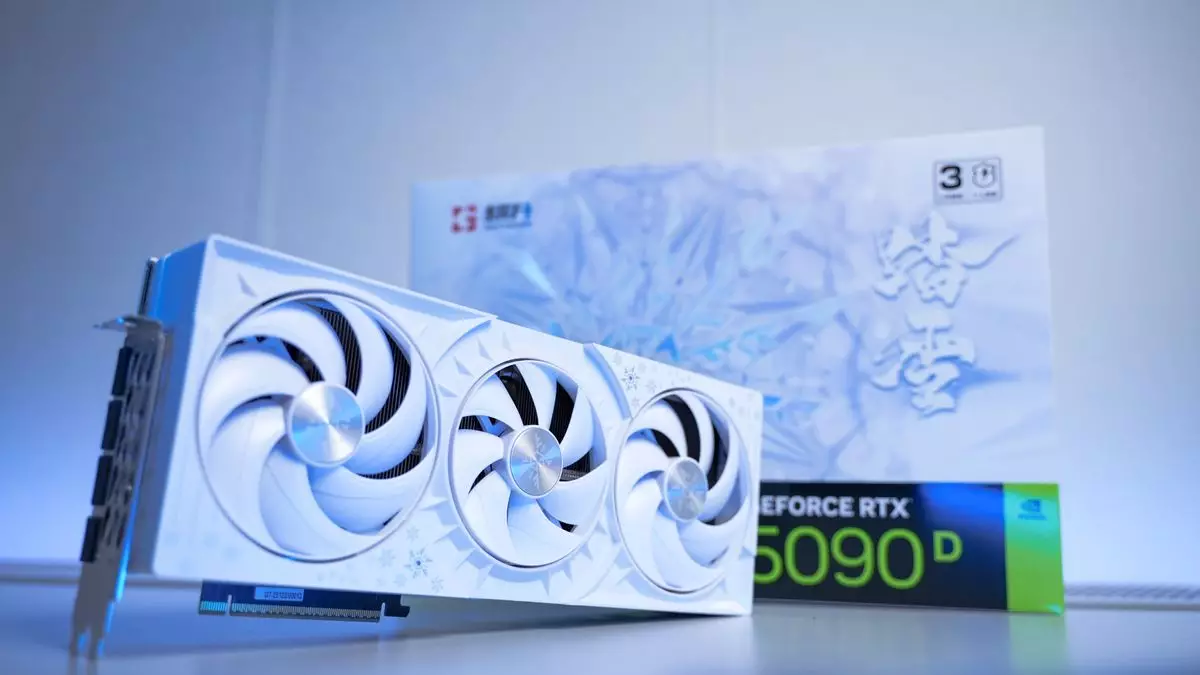The tech world stands on the brink of a significant new release, as Nvidia gears up for the introduction of its RTX 50 series graphics cards. At the forefront of this anticipated launch is Gainward’s notable offering: the RTX 5090 D. This card, adorned with an eye-catching all-white design embellished with snowflakes and sharp, spiky elements encircling its central cooling fan, promises not just functionality, but a striking visual appeal for enthusiasts and gamers alike. Speculation around this model has reached fever pitch, particularly as it hints at the union of impressive aesthetics with cutting-edge technology.
The RTX 5090 D’s design speaks volumes about Gainward’s approach to marketing its product. While blatant branding on hardware can often feel intrusive, the elegant presentation of the Gainward name on the card seems to complement its frosty aesthetics, thus allowing the brand to take pride in its creation without overshadowing the piece itself. This card embodies a unique art form—a synthesis of high-performance technology and avant-garde styling that appeals to users who value not only power but also the visual narrative of their gaming setup.
However, the RTX 5090 D’s design is not without its compromises. The card is a response to strict export regulations imposed by the United States on technology destined for China, especially concerning artificial intelligence and cryptocurrency capabilities. Consequently, this product showcases reduced compute performance and alterations in processing metrics. Notably, both the TPP (Total Processing Performance) and TD (Performance Density) have been scaled back.
While it retains the formidable specifications of its non-D counterpart—32 GB of GDDR7 RAM and a robust 21,760 CUDA cores—the actual performance may fall short of full expectations. Unfortunately, the anticipation surrounding its capabilities is tempered by uncertainty regarding how it will stack up against the forthcoming standard RTX 5090. The reality is that the RTX 5090 D, aesthetically stunning as it is, may not invigorate your gaming rig with the power you desire.
The introduction of the RTX 5090 D also underscores the intricate dance of geopolitics and technology. The antitrust scrutiny Nvidia faced over its acquisition of Mellanox Technologies further complicates the situation. Amid these tensions, China’s government seemed to play a careful balancing act, accepting the deal but attaching stipulations. The geopolitical landscape directly influences product availability, and Nvidia’s workaround with the RTX D series is an illustration of how technology companies are forced to navigate these choppy waters.
Given the limitations imposed on the RTX 5090 D, gamers wondering about the practicality of investing in this product must consider its comparative power against traditional graphics cards slated for release. These sanctions and regulations raise questions about the future of gaming technology within certain markets.
Despite the performance constraints, there is a significant allure to products exclusively available in China. The aesthetic appeal of gaming tools designed for that market often exhibits a creativity that seems to transcend conventional designs available globally. Consider brands like Razer, which has unveiled charming collaborations, or the striking Evangelion OneXPlayer devices that are limited to the Chinese market. Such unique offerings tap into a sense of exclusivity that fuels enthusiasm among collectors and gamers alike, prompting a fervent desire for access to these specially designed products.
While the Gainward RTX 5090 D boasts an enchanting visual palette that would undoubtedly elevate any gaming setup’s look, potential buyers must grapple with the question of performance versus aesthetics. As appealing as it is, the recognition that it may not perform at par with its siblings might temper expectations. It serves as a poignant reminder that beauty, while captivating, can sometimes mask underlying deficiencies in performance. Nevertheless, for those who prioritize aesthetics in their gaming endeavors, the RTX 5090 D remains an intriguing prospect—an embodiment of the delicate balance between design and functionality in the realm of modern technology.

